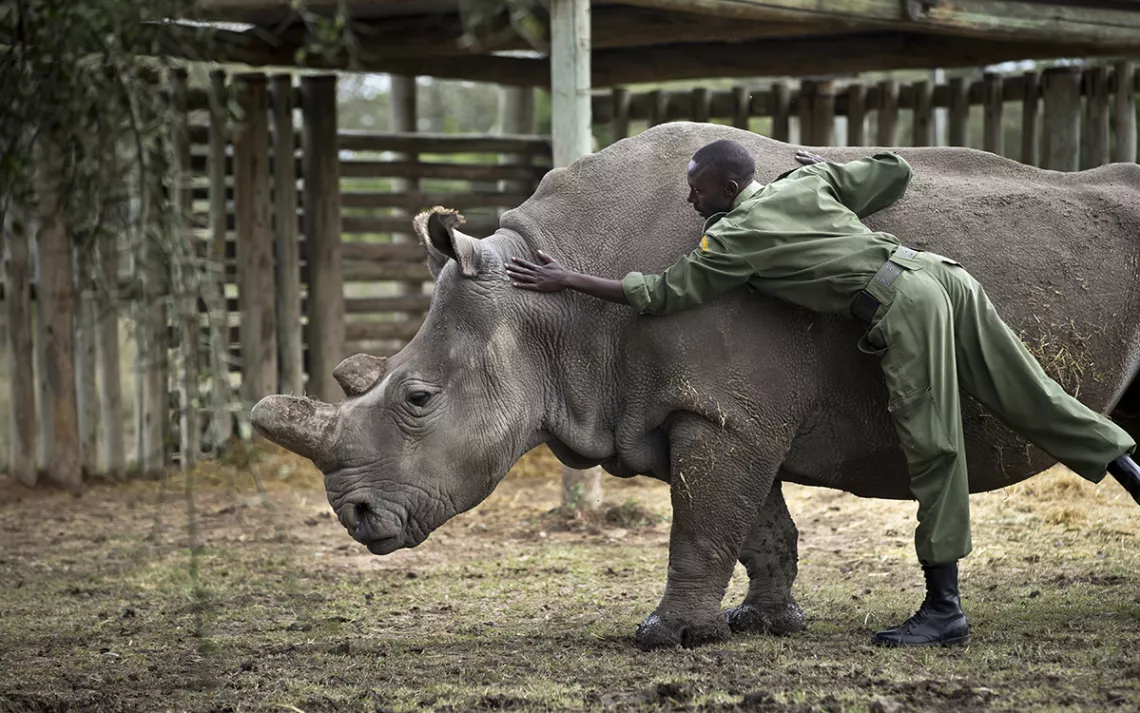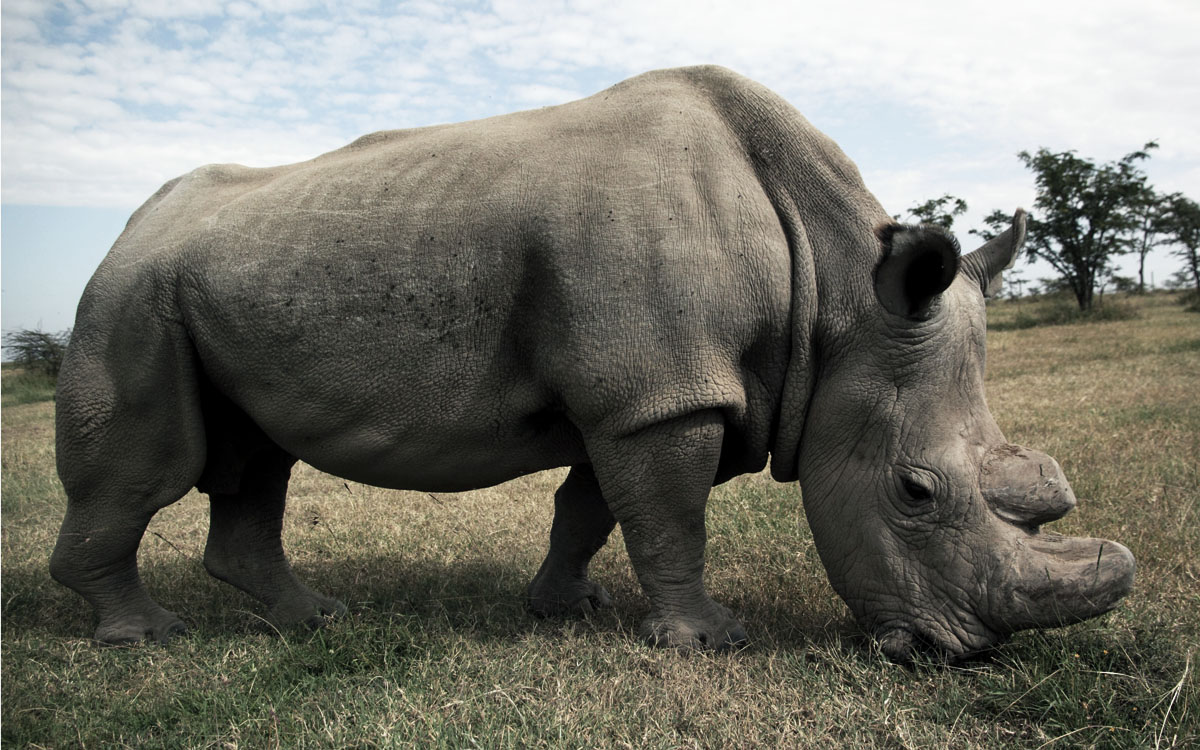How Far Do We Go to Save a Species?
The race to preserve the northern white rhino has a big breakthrough

Najin at Ol Pejeta Conservancy in Kenya in 2014, when she was one of six northern white rhinos left in the world | Photo by Ben Curtis/AP
Ask Thomas Hildebrandt why he walks with a limp, and he will tell you with a quick laugh that he had his arm up to his shoulder inside the back end of an elephant when the elephant decided to sit down.
This boyish German scientist is head of reproduction management at the Leibniz Institute for Zoo and Wildlife Research in Berlin and the leading world expert in the artificial insemination of giant mammals. He just made headlines by announcing the creation of the first in vitro rhino embryo, and soon he will fly to Kenya for his most challenging job yet. He will either go down in history as the hero who saved the world's rarest large mammal—or as the idiot who accelerated its demise.
Last spring, obituaries for Sudan, the last male white northern rhino, made the front page of newspapers around the world. Before his guards at the safari park Ol Pejeta in Kenya put the ailing Sudan to sleep at age 45 (an eternity in rhino terms), a small army of bodyguards protected “the most eligible bachelor in the world” in his last years around the clock with machine guns. At one point the wildlife sanctuary opened a Tinder account for the 5,000-pound colossus, with the polite intro, “I don’t mean to be too forward, but the fate of my species literally depends on me.”
But no one swiped right. Or rather, the only two females of his species left on the planet weren’t available for dating: his 28-year-old daughter, Najin, and his 18-year-old granddaughter, Fatu. Even if they weren’t Sudan's offspring, they couldn’t get pregnant naturally. Najin's damaged Achilles tendons could rupture under the weight of a pregnancy, and Fatu is infertile due to a uterine infection.

Sudan, the last male northern white rhino | Photo courtesy of Ol Pejeta Conservancy
Hildebrandt knew Sudan for 18 years and describes him as “the gentlest of creatures” and an important ambassador for species preservation. Hildebrandt was the one who determined, back in 2014, that none of the remaining white rhinos could reproduce naturally. While he’s one of many scientists around the world racing against time to revive the near-extinct species, Hildebrandt has a distinct advantage: He is the only scientist who was able to get sperm from the last four male white rhinos before their deaths.
This treasure is stored in specialized cryo tanks around the world next to the cells of thousands of other animals, including in Hildebrandt's lab and the “Frozen Zoo” in San Diego. The next step—using those frozen cells to create new embryos—is risky.
For the first time, an international team of researchers has managed to create a hybrid rhino embryo, by fertilizing the oocytes of a southern white rhino with the sperm of a northern white rhino. Seven of these embryos are viable and could be implanted into a living female rhino. Hildebrandt estimates it might take about three years until the first hybrid rhino could be born.
His plan to save the northern rhino goes like this: He will return to Kenya and begin the tricky process of extracting eggs from Naijn and Fatu, the two female survivors. The egg pickup will not be nearly as easy as it is with humans. A woman's eggs lie just a few centimeters beyond the vaginal wall—relatively accessible to an ob-gyn holding a thick needle. Rhino eggs are over six feet inside the body, well beyond the reach of a human arm. Hildebrandt has devised a pathway to reach the eggs through the rectum with a handheld needle, but the eggs are also precariously close to major blood vessels. “The blood vessels are as thick as a child's arm,” Hildebrandt explains wryly. “If you accidentally puncture a vessel, the animals are dead.” With only two females left, he says, “We don’t have the luxury of trial and error.”
He has successfully accomplished the egg pickup with a dozen southern white rhinos—a close enough relative to the northern white rhino that some scientists argue that the two are subsets of the same species. (Hildebrandt disagrees with this theory, arguing that the two occupy different roles in their respective ecosystems and have such different bone structures that the two are very much separate species at this point.) The southern white rhino was also on the edge of extinction in the early 20th century—reduced to 20 individuals living in South Africa—but today, they number about 25,000.
If Hildebrandt can successfully extract eggs from Fajin and Natu, those eggs will be flown to a specialized lab in Italy, where scientists will attempt in vitro fertilization and then ship any resulting embryos back to Kenya to be implanted into surrogate southern rhinos. This will also be a first: Hildebrandt has accomplished IVF with elephants and rhinos in Asia, but nobody has managed it with a southern rhino. “We have to do this as soon as possible,” Hildebrandt urges. “We must not lose any more time, because the quality of the eggs declines with each year that passes.”
But even if everything goes right, the offspring of Fajin, Natu, and the frozen sperm of the deceased rhinos won’t have enough genetic diversity to guarantee the health of future generations. Therefore Hildebrandt is working with researchers who are attempting to create stem cells from the extracted cells, primarily at the Frozen Zoo in San Diego. “We need both methods,” he explains—the artificial reproduction and the stem cell research.
In Japan, researchers turned cells taken from a mouse’s tail into stem cells, and then embryos. But out of the 1,348 embryos they made, only eight pups were born. Will this work with 5,000-pound rhinos? The same team at Kyushu University is working to replicate the technique with rhinos and has so far generated 12 rhino stem cell lines, according to Hildebrandt. But the process will certainly not move as swiftly as with mice—the behemoths’ pregnancy lasts 16 months.
Hildebrandt is against cloning, though, even if it were possible to clone his beloved Sudan, whose photos line the walls of his office. “Sudan was the most famous rhino in the world, and it would be beautiful to have a little Sudan,” he says. “But the success rate is minor. For Dolly the sheep, hundreds of embryos had to be used. Cloning is inefficient, very expensive, and does not have widespread support. Species protection and cloning don’t go together.”
That said, Hildebrandt does play a small role in an ambitious Seoul-based attempt to revive the woolly mammoth, which died out about 10,000 years ago. Researchers have taken DNA from frozen mammoth carcasses and, by way of the CRISPR gene-editing technique, inserted mammoth genes into elephant genomes. The goal is to create embryos and bring them to term using elephants as surrogate mothers.
While Hildebrandt feels every success, new insight, and progress helps the prospects of endangered species, he sees these efforts critically. “We should prioritize animals that are still alive, such as the rhinos,” he says, “rather than animals that have long been extinct.”
Hildebrandt is optimistic. “In 10 to 20 years, we will see a healthy population of the white rhino,” he says. “The possibilities sound futuristic but are very solid.” In any case, the efforts will benefit the other rhino species, almost all of which are threatened as well. For instance, Hildebrandt just returned from Borneo, where he does similar fertility work with the Sumatran rhino, which is down to about 30 individuals.
Sceptics, however, wonder if conservation money is better spent on preserving a few of the other 25,128 species on the red list of the IUCN (International Union for Conservation of Nature) rather than spending millions on far-fetched attempts to revive species that are already extinct or near-extinct.
Hildebrandt objects to the idea that the project costs millions. His work on the project, he says, only cost his institute about 50,000 euros per year. “The rhinos are popular, but nobody gives us any money. If we had a million dollars, we’d have a rhino baby already.”
He also does not see protecting species that are still around and reviving nearly extinct ones as being in opposition to one another. “It is simply not acceptable to see these animals go extinct,” he says, visibly angry at the thought. “It is the Kalashnikov that kills these animals, not evolution.”
Hundreds of thousands of white rhinos roamed within the African continent at the beginning of the 19th century. Sport hunting, habitat loss, and then civil war and poaching all took their toll. The last northern white rhino was seen in the wild in 2006, in the Democratic Republic of the Congo. Rumors that rhino horn is everything from an aphrodisiac to a cancer cure continue to fuel a poaching epidemic of rhinos around the world. This is despite the fact that rhino horn mainly consists of keratin, the same stuff your toenails are made of. Just like biting your nails doesn’t make you any more potent or healthier, nor does consuming a rhino’s pulverized horn.
Hildebrandt is trying to preserve the rhino for future generations because he hopes those generations will be more responsible. “If people weren’t so wacky to mystify the rhinos and pay a fortune for a horn,” he says, “these animals would still be among us. Humans did this to these animals. And so we as scientists have to find the solution to prevent them from going extinct.”
 The Magazine of The Sierra Club
The Magazine of The Sierra Club



